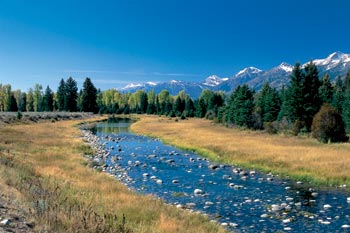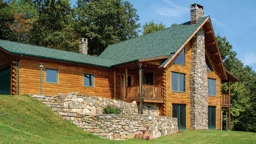 For log home owners, an appreciation for nature is practically a given. A new discipline, "biomimicry," aims to take appreciation for nature a step further, imitating natural designs to solve human challenges in a sustainable way.
For log home owners, an appreciation for nature is practically a given. A new discipline, "biomimicry," aims to take appreciation for nature a step further, imitating natural designs to solve human challenges in a sustainable way. According to the Biomimicry Institute (biomimicryinstitute.org), because nature has evolved solutions to many of the problems that humans face, the idea is to use nature as a model, measure and mentor for innovation. In other words, we can learn from the natural world by using nature as a standard for what works—even home design.
Natural Technology
Janine Benyus, author of Biomimicry: Innovation Inspired by Nature and president and founder of the Biomimicry Institute, explains that biomimicry has many practical applications in the arena of architecture and home decor. For example, she says, Sto Corp., a specialty coatings company, has developed Lotusan, an exterior coating that mimics the ability of the lotus leaf to repel water and dirt.Product design of this type is one aspect of biomimicry, says Janine, who also co-founded the Biomimicry Guild, a company of consulting biologists who work with clients—such as the American Society of Interior Designers and the furniture and office-equipment company Herman Miller—to implement biomimicry-inspired innovation.
Principles of Life
The bigger picture of biomimicry is studying how nature's intricate design works, Janine says. We've outlined the movement's primary principles and how they might relate to your home's design:Life is locally attuned. Organisms build with local materials. Therefore, if you're building a log home, try to choose local materials or at least products harvested and produced within a few hundred miles of where you'll live. It beats shipping materials thousands of miles. Janine owns a log cabin in Montana, built in 1926 by Finnish miners, and notes that some log-home owners in her area buy wood species from the farthest reaches of North America when Ponderosa pine is abundant in their own back yard.
"The best way to save the environment and your local economy is to buy local," she explains. You also can explore local options for powering your home. Before hooking up to the grid, see if the area is conducive to wind or water power. Inside your home, you can implement the principle of being locally attuned by decorating with local objects, images and colors.
Life tends to optimize, rather than maximize. In other words, instead of designing a house with a room for every purpose—or adding extra rooms onto your existing house—you might decide that some rooms can have two or three purposes, and just move furniture around when necessary. This is the choice Janine made with her log home. "At first we were going to add on," she says, "but we realized that with a little change in our own behavior, we didn't have to."
Life maintains itself through turnover, and life is modular. The natural world often consists of small modular parts that can be moved around and replaced easily. For example, rather than wall-to-wall carpet, you might choose carpet tiles, so that "if you destroy one tile, you can send it back to the manufacturer and get it replaced," says Janine. Also, when you're done with something—a piece of furniture, an appliance—think about how it can be recycled, and purchase items with that end in mind. Janine notes that Europe's "take-back laws" for appliances are an example of following these principles.
Successful organisms adapt and evolve. Think long term when building or decorating your home. "Building a home that's difficult to change in 10 years when your life changes is very wasteful," Janine explains. To implement this idea, think open floor plans, and moveable walls.
Love of life
We find things beautiful because they are biologically advantageous. This concept can be useful when decorating log homes. For example, we love the sound of running water because running water is healthier to drink, and "a fountain is a very simple decorating device," says Janine. As an added bonus, a fountain helps clean air, bringing us back to the tenets of smart design.The Biomimicry Design Spiral
The Biomimicry Guild and its collaborators have developed the following process for using nature as a model for design:Determine the human need – the specific problem to be resolved – and the function you want the design to accomplish.
Ask how nature accomplishes this function, and determine the various conditions under which it does so.
Find the best examples of the way nature solves the challenges you face. Ask, "Whose survival depends on this?"
Determine the repeating patterns and processes in nature for solving your particular problem.
Develop solutions that apply the lessons from your natural models; think about mimicking form, function, and/or ecosystem.
Ascertain how your solution compares to the successful principles of nature. Identify ways to improve your design, and, if necessary, begin the Biomimicry Design Spiral process again, based on your needs.











